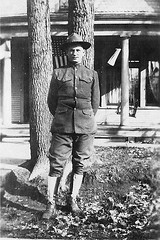World geography notes on WWI
- 1914 -1918
- France (and Britian) vs Deutschland
- new war technology included biplanes, modern machine guns, tanks and poison gas (mustard gas, chlorine, phosgene).
- stalemate - little movement
- trench warfare -
- war of attrition - war of deliberate sacrifice or loss of troops to death in battle; the side with the largest number of combatants was expected to prevail.
- huge casualties - some 16 million dead.
US entered war in 1917.
- delayed involvement in war due to large German-American immigrant population as well as Isolationist (non-involvement) spirit.
- German immigrants largest group of European immigrants to US. Ex: town of Minden.
Treaty of Versailles notable for leading to WWII.
WWII
Largely a repeat of WWI.
French & British vs Germany (joined by Italy).
- 1939 - 1945
- US enters war as ally of GB in 1941.
- Hitler's blitzkrieg ("lightning warfare") results in takeover of small nations such as Poland, Czechoslovakia, Netherlands, etc.
- Successful German takeover of France.
- Battle of Britain (1940) - German bombing of London and English cities in preparation for invasion by troops. Royal Air Force (RAF) proves equal to the attack by the Luftwaffe (German Air Force).
Turning point of the war.
- German invasion of Russia was unsuccessful. German control of Russian Black Sea oilfields was unsuccessful.
- Germans depended on synthetic fuel - gasoline made from coal. In 1944 the bombing of those plants by US and British bombers crippled the German forces.
- Invasion of US/British forces at Normandy, France, begins the displacement of Germany's forces in Western Europe.
- War is concluded by the invasion of Germany by US/British forces in the west and by successful Russian troops which invaded Germany from the east.
skip to main |
skip to sidebar
For students and parents who love education and exploration of the social sciences . . .
Search This Blog
Followers
Blog Archive
-
▼
2010
(346)
-
▼
December
(10)
- Semester exam in Trudeau's world geography: re-cyc...
- Farenheit 451: first 50 pages online, free
- Classic social studies literature: Fahrenheit 451
- Deutschland: Volkswagens and Porsches
- The basics on Germany / Deutschland
- Swing Kids: young Germans avoiding the Nazis
- Western Europe: battleground for the great wars, W...
- Quizzes and soap / France
- Quiz on France next week: map and web site notes
- Dec 1: first day of the eight days of Hannukah in ...
-
▼
December
(10)

